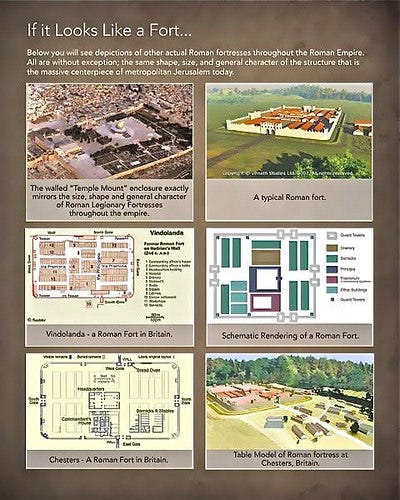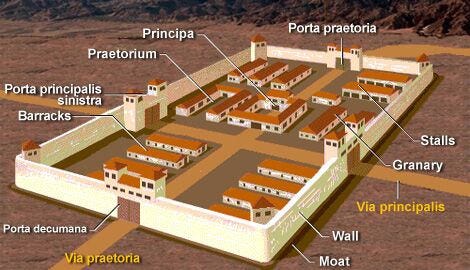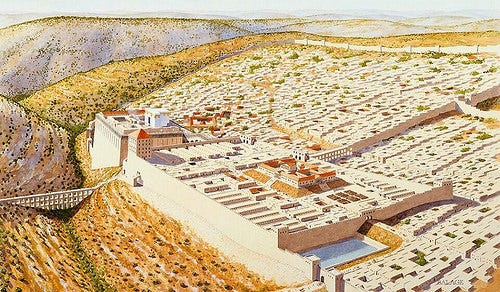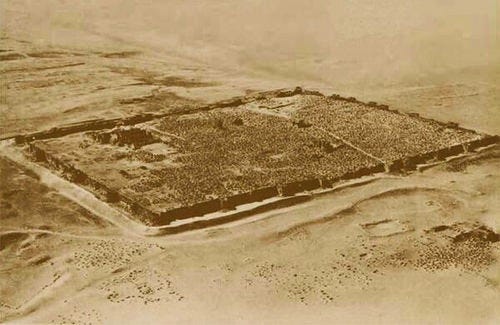Jerusalem’s Greatest Architectural Prank
Let’s face it: history is written by the winners, but archaeology is often dug up by the stubborn. And nothing stokes stubbornness like a 2,000-year-old game of “Who Owns This Rock?” For centuries, the Wailing Wall has been venerated as the last remnant of Judaism’s Second Temple. But what if it’s actually the last standing bar tab from Herod’s Roman buddies? Enter Fort Antonia, the colossal Roman fortress that, according to some heretical scholars, is the so-called “Temple Mount.” And if they’re right, then the Wailing Wall isn’t Jewish at all. It’s Roman. Cue the historical outrage.
Fort Antonia: Rome’s Middle East Timeshare
Herod the Great, that sycophantic client king of Rome, didn’t just build temples, he built a Roman military Walmart. Fort Antonia, named after his drinking pal Mark Antony, wasn’t some dinky castle. Josephus, the ancient equivalent of a war correspondent with a flair for drama, described it as a 40-acre monstrosity with 60-foot walls, four towers (one 105 feet tall), and enough amenities to make a legionnaire forget he was stationed in the desert. It had baths, barracks, and even “slippery tiles” to keep rebellious locals from scaling the walls. Sounds more like a Vegas resort than a temple annex.
Yet modern archaeologists insist on shrinking Antonia down to a footnote, cramming it into a corner of the Temple Mount like an unwanted in-law. Why? Because tradition dies harder than a gladiator in the Colosseum.

The Wailing Wall: A Roman Retaining Wall?
Here’s the kicker: the Wailing Wall’s masonry matches Roman construction, not Jewish. The massive ashlars, the precision cuts, the sheer scale, it’s textbook Roman military engineering. Even the layout of the Haram es-Sharif (the “Temple Mount”) mirrors standard Roman fortresses, like the one still standing in Sergiopolis, Syria. Coincidence? Or proof that Jerusalem’s holiest site was actually Rome’s local bad ass base?
And let’s talk about those aerial bridges. Josephus mentions two 600-foot walkways connecting Antonia to the Temple, convenient for quick troop deployments during Passover riots. But where are they now? Gone, like Pilate’s patience. Traditionalists claim the Jews destroyed Antonia during the siege of 70 CE, but Josephus hints it was just the bridges. The fortress itself? Probably repurposed by Titus’s boys as a victory lap.


The Case of the Missing Temple Stones
Jesus supposedly prophesied the Temple’s destruction, saying “not one stone [would] be left upon another.” Yet the Wailing Wall’s stones are very much stacked. Meanwhile, in the City of David, where alternative theorists place the real Temple, archaeologists haven’t found a single surviving temple stone. Curious. Unless, of course, the “Temple Mount” was always Antonia, and the real Temple was elsewhere, reduced to rubble as foretold.
Even the “place of trumpeting” stone, found near the Wailing Wall, doesn’t prove much. Romans loved repurposing local artifacts, ever seen a menorah on the Arch of Titus?

History’s Best-Kept Secret (or Worst-Kept)
The Wailing Wall as Fort Antonia’s remnant isn’t just a fringe theory, it’s a middle finger to centuries of dogma. If true, it means Jerusalem’s most contested real estate isn’t a temple wall at all. It’s a Roman barracks.
So next time you see pilgrims weeping at the Wall, remember: they might be mourning the wrong ruin. And if you’re a Roman history buff, pour one out for Fort Antonia, the fortress Jerusalem forgot, but archaeology might just resurrect.
Primary References:
- Josephus, Flavius – The Jewish War (Book 5, Chapter 5) – Describes Fort Antonia’s size, structure, and connection to the Temple.
- Josephus, Flavius – Antiquities of the Jews (Book 15, Chapter 11) – Details Herod’s construction projects, including Antonia.
Archaeological & Scholarly Sources:
- Popular Archaeology (2023) – Antonia: The Fortress Jerusalem Forgot – Argues for Fort Antonia’s dominance over the Temple Mount.
- Leen Ritmeyer (1992) – The Temple and the Rock – Challenges traditional Temple Mount placement; suggests Antonia’s remains are misidentified.
- Ernest L. Martin (2000) – The Temples That Jerusalem Forgot – Controversial thesis claiming the Temple was south of the Dome of the Rock, with the Haram es-Sharif being Antonia.
- Benjamin Mazar (1975) – The Mountain of the Lord – Excavations near the Southern Wall; notes Roman engineering in Herodian structures.
Supporting Evidence:
- Roman Military Architecture – Comparisons to forts like Castra Praetoria (Rome) and Sergiopolis (Syria).
- The “Place of Trumpeting” Stone – Discovered near the Wailing Wall, possibly repurposed.
- Titus’s Arch (Rome) – Depicts Temple artifacts, but no clear depiction of Antonia’s destruction.
From euronimus.substack
Disclaimer: We at Prepare for Change (PFC) bring you information that is not offered by the mainstream news, and therefore may seem controversial. The opinions, views, statements, and/or information we present are not necessarily promoted, endorsed, espoused, or agreed to by Prepare for Change, its leadership Council, members, those who work with PFC, or those who read its content. However, they are hopefully provocative. Please use discernment! Use logical thinking, your own intuition and your own connection with Source, Spirit and Natural Laws to help you determine what is true and what is not. By sharing information and seeding dialogue, it is our goal to raise consciousness and awareness of higher truths to free us from enslavement of the matrix in this material realm.
 EN
EN FR
FR


























